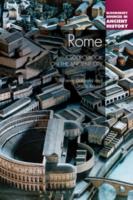
Bloomsbury (2018) p/b 258pp £25.99 (ISBN 9781441194190)
Literary and epigraphic sources are arranged thematically in eleven chapters covering such topics as commerce and leisure, spectacle, day and night, religion, politics, disasters, death. Sub-sections in each chapter are given a concise introduction with further reading recommended from the extensive total bibliography.
This approach offers something different from guides and collections of sources where the focus is architectural, historical or topographical, as e.g. Donald Dudley’s Urbs Roma (1967). Here the authors want to provide the reader with ‘an experience that is at the intersection of topography, social history, and cultural studies’. In this they are largely successful, but the danger of this approach is that it cannot hope to treat the wide range of topics thoroughly. Chapter 6 covers religion from the Capitoline triad to Christianity with a selection of 17 sub-sections each with sources well chosen to illustrate the rich variety and strangeness of Roman cults and worship.
The introductions to the topics can become more informative than the sources themselves. For example, little insight into the cult of Mithras can be gained from the two dedications and an epitaph selected here (but Mithraic sources are notably sparse or hostile). Bathing has only four entries, all well chosen, including Seneca’s graphic description of the sounds from the baths. It is a shame they did not include Marcus Aurelius’ fastidious comment, ‘What’s your impression of bathing: oil, sweat, filth, greasy water, everything revolting’ (Meditations 8.24). But that is merely to air a personal choice when the authors are well aware of less salubrious aspects of Rome, whether olfactory ‘smells of food, waste, various industries, and body odors’ (p.27), or unhygienic ‘streets … strewn with animal and human feces and rotting animal carcases’ (p.203).
Sometimes extracts might have been extended in order to show the significance in context, such as Suetonius on teachers and doctors exempt from expulsion from Rome (Augustus 42) or given citizenship (Caesar 42). There are rare problems with translating: in the extract from Vitruvius 1.4.1 they translate deinde sic vitabitur palustris vicinitas twice, as if they forgot to delete the version not selected. In the same passage the choice of translating meridies by ‘midday’ instead of ‘the south’ does not help to clarify Vitruvius, and the omission of a translation for item quod spectat ad occidentem makes the sentence unintelligible. In the next excerpt (Cicero de republica II. 5. 10-11) the omission of in mare and a mari from the translation does not make clear the convenience of the river for trade overseas, although the sea is finally mentioned in a subsequent sentence. The omission of the simple word hunc from the translation at Aeneid 8.351 makes an uncomfortable apposition: ‘this grove, … a (for hunc) hill with its leafy peak’.
The notes are brief, but helpful, although they could be expanded in a few places to offer explanation of such items as ‘Jupiter Fagutal’ (Jupiter Fagutalis ‘of the Beech Tree’, ‘because his shrine is there’ Varro De Lingua Latina 5.152) or Maro (Propertius 2.32.14). Translations tend to keep close to the Latin and Greek, but there are one or two sentences that are accurate but overly literal. Suetonius Gaius 26.5 is rendered ‘At a gladiatorial contest, sometimes when the awnings were drawn back when the sun was burning the most, he was forbidding that anyone be let out.’ There is one ‘transatlantic’ translation that English readers may find amusing: ‘the requirement that the pontifex maximus live in a public house’ (Dio 54.27.3).
As an introduction to Rome and its teeming population, this is very useful and stimulating collection of sources. The city seems less robust, but more resilient in the face of flood, fire, collapse and epidemics. The monuments are not neglected, whether temples, walls, columns, gates, aqueducts, bridges, warehouses, triumphal arches, in fact the whole infrastructure of the city, and each with associated activity. One might, with a little hyperbole, say all Roman life is here.
Alan Beale
